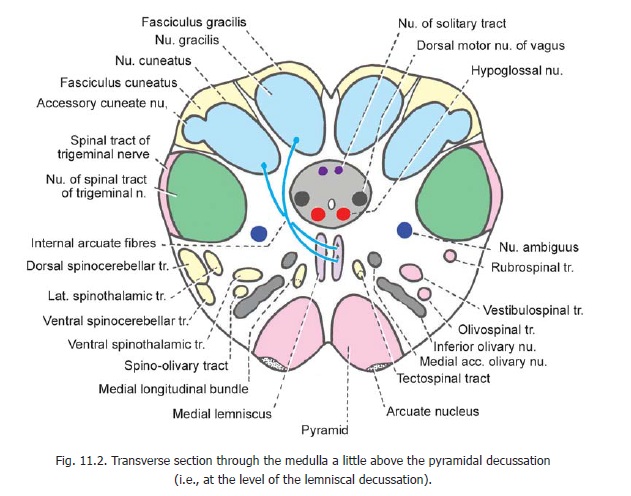Chapter: Human Neuroanatomy(Fundamental and Clinical): Tracts of Spinal Cord and Brainstem
Tracts of Spinal Cord and Brainstem
Tracts of Spinal Cord and Brainstem
We have seen that a collection of nerve fibres within the central nervous system, that connects two masses of grey matter, is called a tract. A tract may be defined as a collection of nerve fibres having the same origin, course, and termination. Tracts may be ascending or descending. They are usually named after the masses of grey matter connected by them. Thus, a tract beginning in the cerebral cortex and descending to the spinal cord is called the corticospinal tract, while a tract ascending from the spinal cord to the thalamus is called the spinothalamic tract. We have noted that tracts are sometimes referred to as fasciculi (= bundles) or lemnisci (=ribbons). The major tracts passing through the spinal cord and brainstem are shown schematically in Fig. 9.1. The position of the tracts in a transverse section of the spinal cord is shown in Fig. 9.2, and at ascending levels of the brainstem in Figs. 11.1 to 11.3, 11.5, and 11.7 to 11.9. It will be a useful exercise for the student to follow the course of each tract described below by noting its position in each of these figures proceeding from Figs. 11.1 to 11.9 in the case of ascending tracts, and in the reverse order for descending tracts. In studying these figures it must be remembered that in actual fact the boundaries of areas occupied by the fibres of each tract are not clear cut. There is considerable overlap of the territories of various tracts. The lines of demarcation shown in the diagrams are, therefore, approximate and artificial. It may also be remembered that the position of a particular tract varies at different levels of the spinal cord; and that some of the tracts shown in Fig. 9.2 are present only in the upper part of the cord.





Related Topics